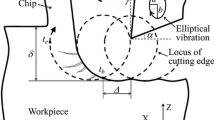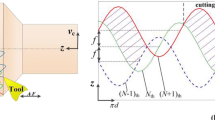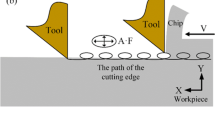Abstract
In the metal cutting process, an increased shear angle generally leads to lower cutting forces and improved machining performance. It has been reported earlier that 2D vibration-assisted machining (VAM) increases the equivalent shear angle and decreases the chip thickness via an elliptical pulling motion of the tool rake face moving away from the deformed chip. Researchers have conducted several experimental and finite element studies and revealed that an increase of shear angle in 1D VAM as well and this process which started much earlier than 2D VAM is widely used in the machining industries. However, no systematic analysis of chip deformation in 1D VAM has so far been carried out regarding the equivalent shear angle. In this research study, several cutting tests have been conducted initially at a very low frequency (0.5 Hz) and the deformation of chip was found smaller compared to conventional machining. Based on the force analysis, an energy-based analytical model has been derived to evaluate the equivalent shear angle. The model was then verified at ultrasonic 1D VAM against cutting speed ratios. Four different metals have been tested including stainless steel, brass, annealed tool steel, and titanium. The results show that a lower speed ratio in ultrasonic 1D VAM will lead to a decreased chip thickness and as such decreased chip compression ratio. The developed model has been found to be able to well predict the equivalent shear angle for ultrasonic 1D VAM of several types of metal.












Similar content being viewed by others
Abbreviations
- A :
-
Amplitude of vibration along the tangential direction
- f :
-
Frequency of vibration
- ω :
-
Frequency of angular vibration
- v c :
-
Nominal cutting speed
- (v t)max :
-
Maximum tool speed during vibration
- R s :
-
Speed ratio
- t 0 :
-
Depth of cut
- t 1 :
-
Formed chip thickness
- A c :
-
Undeformed chip area
- A f :
-
Contact area at tool flank
- τ :
-
Shear stress
- γ :
-
Shear strain
- w :
-
Width of cut
- θ f :
-
Tool flank angle
- β :
-
Friction angle
- ϒ ne :
-
Instantaneous effective rake angle
- α :
-
Tool negative rake angle
- r :
-
Cutting edge radius
- φ :
-
Shear angle
- φ e :
-
Equivalent shear angle in 1D VAM
- φ eff :
-
Instantaneous effective shear angle in CM
- ψ :
-
Phase of vibration
- µ f :
-
Coefficient of friction between the tool rake and the chip
- δ f :
-
Stress of material beneath the tool flank
- s :
-
Elastic spring-back height of freshly machined workpiece surface
- H :
-
Material hardness
- E :
-
Elastic modulus
- F t :
-
Thrust force
- F c :
-
Cutting force
- F c–s :
-
Elastic spring force
- F c–e :
-
Elastic deformation force
- F c–p :
-
Plastic deformation force
- \(\overline{{F_{{{\text{c}} - {\text{s}}}} }}\) :
-
Average value of elastic spring force
- \(\overline{{F_{{{\text{c}} - {\text{e}}}} }}\) :
-
Average value of elastic deformation force
- F c-CM :
-
Cutting force in conventional machining
- D s :
-
Tool–workpiece engagement step/Tool–workpiece disengagement step
- D e :
-
Elastic deformation step
- D p :
-
Plastic deformation step
- D r :
-
Elastic recovery step
- k s, k e, k d :
-
Constants derived from low-frequency 1D VAM
- k 1, k 2 :
-
Scaling constant
- V :
-
Volume of material removed per second
- E SP-VAM :
-
Specific energy consumed in 1D VAM
- E SP-s :
-
Specific energy consumed in the tool–workpiece engagement step
- E SP-e :
-
Specific energy consumed in elastic deformation step
- E SP-p :
-
Specific energy consumed in plastic deformation step
- E SP-CM :
-
Specific energy consumed in CM
References
Arcona C, Dow TA (1998) An empirical tool force model for precision machining. J Manuf Sci Eng 120:700–707. https://doi.org/10.1115/1.2830209
Arif M, Zhang X, Rahman M, Kumar S (2013) A predictive model of the critical undeformed chip thickness for ductile-brittle transition in nano-machining of brittle materials. Int J Mach Tools Manuf 64:114–122. https://doi.org/10.1016/j.ijmachtools.2012.08.005
Astakhov VP, Xiao X (2008) A methodology for practical cutting force evaluation based on the energy spent in the cutting system. Mach Sci Technol 12:325–347. https://doi.org/10.1080/10910340802306017
Lotfi M, Amini S (2018) FE simulation of linear and elliptical ultrasonic vibrations in turning of Inconel 718. Proc Inst Mech Eng Part E J Process Mech Eng 232:438–448. https://doi.org/10.1177/0954408917715533
Ma C, Shamoto E, Moriwaki T, Wang L (2004) Study of machining accuracy in ultrasonic elliptical vibration cutting. Int J Mach Tools Manuf 44:1305–1310. https://doi.org/10.1016/j.ijmachtools.2004.04.014
Moriwaki T, Shamoto E (1995) Ultrasonic elliptical vibration cutting. CIRP Ann Manuf Technol 44:31–34. https://doi.org/10.1016/S0007-8506(07)62269-0
Nath C, Rahman M (2008) Effect of machining parameters in ultrasonic vibration cutting. Int J Mach Tools Manuf 48:965–974. https://doi.org/10.1016/j.ijmachtools.2008.01.013
Nath C, Rahman M, Andrew SSK (2007) A study on ultrasonic vibration cutting of low alloy steel. J Mater Process Technol 192–193:159–165. https://doi.org/10.1016/j.jmatprotec.2007.04.047
Nath C, Rahman M, Neo KS (2011) Modeling of the effect of machining parameters on maximum thickness of cut in ultrasonic elliptical vibration cutting. J Manuf Sci Eng 133:11007. https://doi.org/10.1115/1.4003118
Shamoto E, Moriwaki T (1994) Study on elliptical vibration cutting. CIRP Ann Manuf Technol 43:35–38. https://doi.org/10.1016/S0007-8506(07)62158-1
Shamoto E, Suzuki N, Hino R (2008) Analysis of 3D elliptical vibration cutting with thin shear plane model. CIRP Ann Manuf Technol 57:57–60. https://doi.org/10.1016/j.cirp.2008.03.073
Xiao M, Karube S, Soutome T, Sato K (2002) Analysis of chatter suppression in vibration cutting. Int J Mach Tools Manuf 42:1677–1685. https://doi.org/10.1016/S0890-6955(02)00077-9
Xu Y, Zou P, He Y, Chen S, Tian Y, Gao X (2017) Comparative experimental research in turning of 304 austenitic stainless steel with and without ultrasonic vibration. Proc Inst Mech Eng Part C J Mech Eng Sci 231:2885–2901. https://doi.org/10.1177/0954406216642262
Zhang X, Arif M, Liu K, Kumar AS, Rahman M (2013) A model to predict the critical undeformed chip thickness in vibration-assisted machining of brittle materials. Int J Mach Tools Manuf 69:57–66. https://doi.org/10.1016/j.ijmachtools.2013.03.006
Zhou M, Eow YT, Ngoi BKA, Lim EN (2003) Vibration-assisted precision machining of steel with PCD tools. Mater Manuf Process 18:825–834. https://doi.org/10.1081/AMP-120024978
Acknowledgements
This project was partially sponsored by Shanghai Pujiang Program (19PJ1404500).
Author information
Authors and Affiliations
Corresponding author
Rights and permissions
About this article
Cite this article
Arefin, S., Zhang, X., Anantharajan, S.K. et al. An Analytical Model for Determining the Shear Angle in 1D Vibration-Assisted Micro Machining. Nanomanuf Metrol 2, 199–214 (2019). https://doi.org/10.1007/s41871-019-00049-z
Received:
Revised:
Accepted:
Published:
Issue Date:
DOI: https://doi.org/10.1007/s41871-019-00049-z




